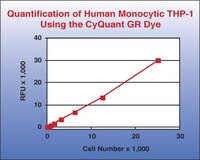ECM512 Sigma-AldrichQCM Chemotaxis Cell Migration Assay, 96-well (5 µm), fluorimetric
The QCM 5 um 96-well Migration Assay utilizes a 5 um pore size, which is appropriate for studying monocyte/macrophage migration.
More>> The QCM 5 um 96-well Migration Assay utilizes a 5 um pore size, which is appropriate for studying monocyte/macrophage migration. Less<<Recommended Products
Overview
| Replacement Information |
|---|
Key Spec Table
| Key Applications | Detection Methods |
|---|---|
| ACT | Fluorescent |
| Description | |
|---|---|
| Catalogue Number | ECM512 |
| Brand Family | Chemicon® |
| Trade Name |
|
| Description | QCM Chemotaxis Cell Migration Assay, 96-well (5 µm), fluorimetric |
| Overview | Also available: Cell Comb™ Scratch Assay! Get biochemical data from a scratch assay! Click Here Introduction Cell migration is a fundamental function of normal cellular processes, including embryonic development, angiogenesis, wound healing, immune response, and inflammation (Clark et al., 1996; Martin, 1997). In immune responses, monocyte migration is critical for providing immunological defense and eliminating infectious agents. Monocytes (macrophage precursors) circulate the blood until encountering specific chemotactic factors that initiate the migration process. Once engaged, monocytic cells transverse the vascular endothelium in a multistep mechanism by: A) E-selectin mediated monocyte rolling B) cell adhesion C) transmigration into the subendothelium (Ashida et al., 2001). During this migration and entering the tissue, monocytes develop/differentiate into mature macrophages, increasing in size, phagocytic activity, and proteolytic enzyme secretion. Once at the site of infection, mature macrophage respond to infection by phagocytosis, cytokine secretion, respiratory burst, T-cell antigen presentation, and digestive enzyme secretion (Holevinsky & Nelson, 1995). Microporous membrane inserts are widely used for cell migration and invasion assays. The most widely accepted of which is the Boyden Chamber assay. However, current methods of analysis are time-consuming and tedious, involving cotton swabbing of non-migrated cells on the topside of insert, manual staining and counting. Recently a fluorescence blocking membrane insert was introduced to address these issues; however, this approach requires labeling of the cells with Calcein-AM and extensive washing to remove free Calcein before cell migration. The effect of this treatment on cell behavior/migration remains questionable. The Chemicon QCM™ 96-well 5 μm Migration Assay does not require cell labeling, scraping, washing or counting. The 96-well insert and homogenous fluorescence detection format allows for large-scale screening and quantitative comparison of multiple samples (Gildea et al., 2000). In the Chemicon QCM™ 5 μm 96-well Migration Assay, migratory cells on the bottom of the insert membrane are dissociated from the membrane when incubated with Cell Detachment Buffer. These cells are subsequently lysed and detected by the patented CyQuant GR® dye (Molecular Probes). This green-fluorescent dye exhibits strong fluorescence enhancement when bound to cellular nucleic acids (Jones et al., 2001). Most migration assays utilize an 8 μm pore size, as this is appropriate for most cell types, e.g. epithelial and fibroblast cells. The Chemicon QCM™ 5 μm 96-well Migration Assay utilizes a 5 μm pore size, which is appropriate for studying monocyte/macrophage migration. The system may be adapted to study different types of cell migration, including haptotaxis, random migration, chemokinesis, and chemotaxis. The Chemicon QCM™ 5 μm 96-well Migration Assay provides a quick and efficient system for quantitative determination of various factors on cell migration, including screening of pharmacological agents, evaluation of integrins or other adhesion receptors responsible for cell migration, or analysis of gene function in transfected cells. In addition, Chemicon continues to provide numerous migration, invasion, and adhesion products including: Application The Chemicon QCM™ 96-well 5μm Migration Assay is ideal for studying chemotaxis cell migration. The quantitative nature of this assay is especially useful for large scale screening of pharmacological agents. The 5 μm pore size of this assay's Boyden chambers is appropriate for studying monocyte/ macrophage migration. Each kit provides sufficient materials for the evaluation of 96 samples. The Chemicon QCM™ 5μm 96-well Migration Assay is intended for research use only; not for diagnostic applications. |
| References |
|---|
| Product Information | |
|---|---|
| Detection method | Fluorescent |
| Quality Level | MQ100 |
| Applications | |
|---|---|
| Application | The QCM 5 um 96-well Migration Assay utilizes a 5 um pore size, which is appropriate for studying monocyte/macrophage migration. |
| Key Applications |
|
| Biological Information | |
|---|---|
| Species Reactivity |
|
| Physicochemical Information |
|---|
| Dimensions |
|---|
| Materials Information |
|---|
| Toxicological Information |
|---|
| Safety Information according to GHS |
|---|
| Safety Information |
|---|
| Storage and Shipping Information |
|---|
| Packaging Information | |
|---|---|
| Material Size | 1 plate |
| Material Package | 96 wells |
| Transport Information |
|---|
| Supplemental Information |
|---|
| Specifications |
|---|
| Global Trade Item Number | |
|---|---|
| Catalogue Number | GTIN |
| ECM512 | 04053252278402 |
Documentation
QCM Chemotaxis Cell Migration Assay, 96-well (5 µm), fluorimetric MSDS
| Title |
|---|
References
| Reference overview | Pub Med ID |
|---|---|
| Toxicity and intraocular properties of a novel long-acting anti-proliferative and anti-angiogenic compound IMS2186. Iryna A Falkenstein,Lingyun Cheng,Flossie Wong-Staal,Ajay M Tammewar,Erin C Barron,Gabriel A Silva,Qi-Xiang Li,Dehua Yu,Michelle Hysell,Guohong Liu,Ning Ke,James E Macdonald,William R Freeman Current eye research 33 2008 Show Abstract Full Text Article | 18600493
 |
Brochure
| Title |
|---|
| Advancing cancer research: From hallmarks & biomarkers to tumor microenvironment progression |
| Cell Migration and Invasion: Choosing the Right Assay |
| EpiGRO™, EndoGRO™ and FibroGRO™ Reagents |









